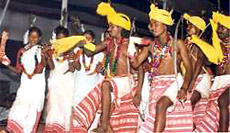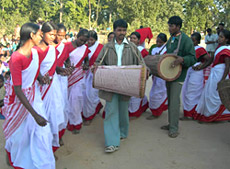By nature, the Santhals love Dance, Music and wine. There cannot be a festival without these. Their fairs and festivals are very colorful.
The Santhals celebrate their biggest festival, Sohoray, from the end of Paush and for the entire month of Magh. They also celebrate festivals like Janthad Lonan Puja, Baha Utsav, Aerak Parba or Ashare Puja and Sakranti (Fagu) Parba (Ijam).
"Karam" festival is celebrated by the Santhals in the month of Aswin (September- October) in order to have increased `wealth and progeny` and to get rid of the evil spirits. During this festival, two youths after being purified, fetch two branches of Karam tree from the forest and plant them just outside the house. The head of the household offers rice beer and other articles to Manjhi Haram and Maran Buru and pray for the prosperity of the house. This worship is followed with singing, dancing and playing of instrumental music. All those present there, are given rice-beer. The traditional dress of Santhal women is called Pandhat, which is a covering from the chest to the foot. Bow and arrows are the favourite weapons of Santhals.
Art of the Santhals:
Local mythology includes the stories of the Santhal ancestors Pilchu Haram and Pilchu Bhudi.
Santal music differs from Hindustani classical music in significant ways. The Santal traditionally accompany many of their dances with two drums: the Tamak` and the Tumdak`. The flute was considered the most important Santal traditional instrument and still evokes feelings of nostalgia for many Santal. Santal music and dance both retain connections to traditional celebrations.
 The Santhals are musicians and dancers par excellence and have dances for every imaginable occasion. The martial dances - Golwari and Paikha are marked with vigour, virility and a lot of jumping and leaping in the air. They carry bow and arrows while doing martial dances and perform mock fights and attacks. Their courtship and marriage dances are typical. These dances, romantic and lively in nature, are performed on full moon nights. The loud drumming, resembling thunder, calls the belles of the community and they come dressed in their fineries, adorned with flowers, feathers and assemble under a large banyan tree. The young men come forward taking strides with drums and lilting songs on their lips, and then the dance commences in two rows, their arms interlinking in pairs. The rows surge forward like rhythmic waves and then recede with supple footwork and swaying heads and bodies. The boys in the row opposite play on flutes, drums, and large cymbals and sing songs in perfect harmony. After the dance the boys and girls mingle and have a good chat.
The Santhals are musicians and dancers par excellence and have dances for every imaginable occasion. The martial dances - Golwari and Paikha are marked with vigour, virility and a lot of jumping and leaping in the air. They carry bow and arrows while doing martial dances and perform mock fights and attacks. Their courtship and marriage dances are typical. These dances, romantic and lively in nature, are performed on full moon nights. The loud drumming, resembling thunder, calls the belles of the community and they come dressed in their fineries, adorned with flowers, feathers and assemble under a large banyan tree. The young men come forward taking strides with drums and lilting songs on their lips, and then the dance commences in two rows, their arms interlinking in pairs. The rows surge forward like rhythmic waves and then recede with supple footwork and swaying heads and bodies. The boys in the row opposite play on flutes, drums, and large cymbals and sing songs in perfect harmony. After the dance the boys and girls mingle and have a good chat.
They have their hunting and sowing dances. On Dassai festival men-folk dance from one locality to another. Then there are the Jhika and the Lagren type dances in which men and women dance together. Men form the outer ring and the women the inner circle. The Dhang and Langi are exclusively confined to women. The Lagren has many forms and variations according to the occasion, be it a marriage, a festival or social gathering. All these dances reflect their collective nature, cohesion, community feeling and social awareness. They are great spontaneous collective singers and dancers. The Santhal women and girls can be seen singing and dancing while engaged in their daily chore like sowing, plantation, journeying to and from the forest. They work and sing simultaneously and in between pause for a round of dance. They use song and music as a convenient tool of dancing. Dance is a super ordinate and all the rest is subordinate. They are gay, colorful tribe and enjoy every moment of the life.
 The names of many Santal tunes are derived from the traditional ritual with which they were once associated. Sohrae tunes, for example, were those sung at the Sohrae festival. Santali rituals are mainly comprised of sacrificial offerings and invocations to the spirits, or bongas.
The names of many Santal tunes are derived from the traditional ritual with which they were once associated. Sohrae tunes, for example, were those sung at the Sohrae festival. Santali rituals are mainly comprised of sacrificial offerings and invocations to the spirits, or bongas.
A Santal myth reported by the musicologist Onkar Prasad tells the story of seven brothers who one day killed their only sister in order to eat her. The youngest brother, however, could not eat his portion because he so loved his sister, so he buried it in a white anthill. On this spot there grew a beautiful guloic tree, from which a melodious sound was heard. A passing yugi, who often came to pick flowers, heard this sound and decided to cut a branch from the tree to make the first dhodro banam, an instrument mostly used by Santhali people. The Santhals believe the musical instruments to be a gift from supernatural forces. With the assistance of these instruments, they can communicate with entities from other worlds. They believe that they are physically related to the dhodro banam and consider the instrument to be a human being. Santhal believe that all beauty created by man is destined to disappear with him, and thus the Santal usually bury or burn their exquisitely decorated instruments. This, however, has not always been the general rule. The creators of the songs of the Santal remain anonymous. As soon as a new song appeared, it became common property. There was no distinction made between the performers and the composer.





















